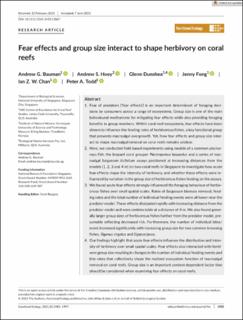| dc.description.abstract | 1. Fear of predators (‘fear effects’) are an important determinant of foraging decisions by consumers across a range of ecosystems. Group size is one of the main behavioural mechanisms for mitigating fear effects while also providing foraging benefits to group members. Within coral reef ecosystems, fear effects have been shown to influence the feeding rates of herbivorous fishes (i.e. browsers), a key functional group that prevent macroalgal overgrowth. Yet, how fear effects and group size interact to shape macroalgal removal on coral reefs remain unclear. 2. Here, we conducted field-based experiments using models of a common piscivorous fish, the leopard coral grouper (Plectropomus leopardus), and a series of macroalgal (Sargassum ilicifolium) assays positioned at increasing distances from the models (1, 2, 3 and 4 m) on two Singaporean coral reefs to investigate how acute fear effects shape the intensity of herbivory, and whether these effects were influenced by variation in the group size of herbivorous fishes feeding on the assays. 3. We found acute fear effects strongly influenced the foraging behaviour of herbivorous fishes over small spatial scales. Rates of Sargassum biomass removal, feeding rates and the total number of individual feeding events were all lower near the predator model. These effects dissipated rapidly with increasing distance from the predator model, and were undetectable at a distance of 4 m. We also found generally larger group sizes of herbivorous fishes further from the predator model presumably reflecting decreased risk. Further, the number of individual bites-event-1 increased significantly with increasing group size for two common browsing fishes, Siganus virgatus and Siganus javus. 4. Our findings highlight that acute fear effects influence the distribution and intensity of herbivory over small spatial scales. Fear effects also interacted with herbivore group size resulting in changes in the number of individual feeding events and bite rates that collectively shape the realised ecosystem function of macroalgal removal on coral reefs. Group size is an important context-dependent factor that should be considered when examining fear effects on coral reefs. | en_US |

